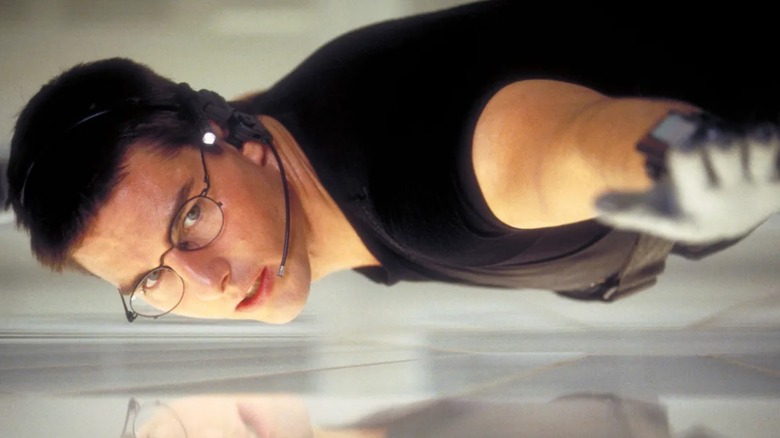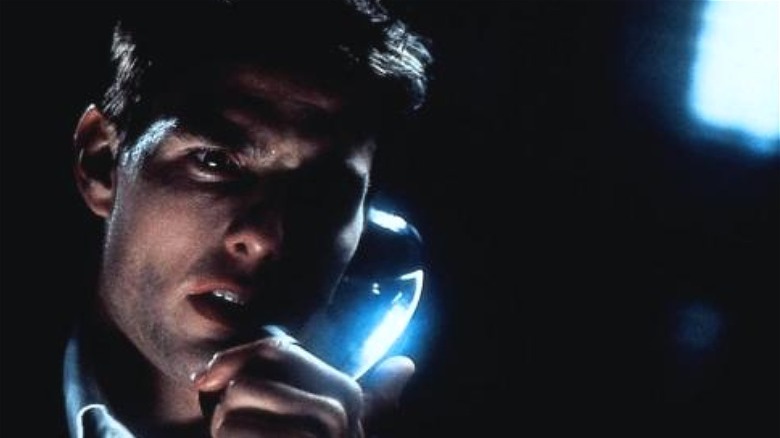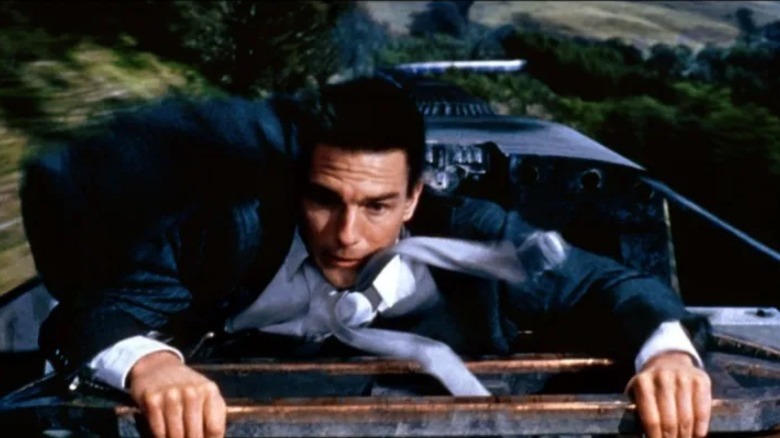How Brian De Palma Pitched Tom Cruise On Mission: Impossible's CIA Break-In Scene
In 1996, Brian De Palma, who directed the first "Mission: Impossible" film, crafted it with the intention of being a standalone spy thriller about an IMF agent called Ethan Hunt who is forced to turn rogue. De Palma couldn't have foreseen the series' critical and commercial success — and that it would act as a launchpad for Tom Cruise's career as a certified action star, who is now synonymous with the death-defying stunts that are a staple in Hunt's evolving journey.
However, the audacious action sequences that are now an intrinsic part of the "Mission: Impossible" films can be traced back to De Palma taking a massive leap of faith. Be it the memorable CIA infiltration sequence or the massive train car showdown towards the end, De Palma pitched these ideas directly to Cruise, who was blown away by the sheer coolness of the storyboards.
"Mission: Impossible" has De Palma's fingerprints all over it, replete with Dutch angles and his favorite split diopter shots. There's also a moody, noir element to the story that is diluted in the sequels — De Palma employs the classic trope of a man being falsely accused by the very organization he serves, where everyone wears literal masks and plays a deft game of deception. The film's opening mission in Prague sets the tone, as the tables are gradually turned on Hunt, who ends up as the sole survivor as his team is hunted one by one.
That tension carries over to the rest of "Mission: Impossible," including the very next scene — a verbal confrontation between Hunt and IMF director Eugene Kittridge (Henry Czerny) in a restaurant. But no other sequence screams tension as the time Hunt and Co. decide to break into the CIA. Yes, I'm talking about the iconic vault scene, where Cruise hangs from the ceiling.
The coolest on-call pitch
After being falsely implicated as the mole, Ethan Hunt — with the aid of two outlawed IMF agents — decides to infiltrate the CIA headquarters in Langley to retrieve an all-important list. This is obviously easier said than done — apart from the borderline impossible nature of the mission, Hunt is a wanted man on the run. The stakes could not possibly be higher, and Brian De Palma further ups the ante by introducing a catch equivalent to the floor-is-lava meme.
The vault is sensitive to sound, pressure, and temperature — that means any sudden noise and movement, or the presence of an unauthorized individual will set off the alarms. What ensues is a masterful portrayal of tense, slow-burn action, where a suspended Tom Cruise glides down a cable and succeeds in doing the impossible after a few extremely close calls, of course.
On the occasion of the 25th anniversary of "Mission: Impossible", Cruise talked about how De Palma pitched the logistics of the vault scene to him — over a phone call. Calling this experience unforgettable, Cruise laid out the details:
"And then we came up with the idea of us having to go into the CIA, [De Palma] came up with that idea, like 'Rififi.' And I remember when he came to me with that idea, I was actually in Japan — and it was an early day of phones — and I remember I was stuck in a traffic jam ... on my way to a premiere. I'll never forget this [... De Palma] was like, 'I gotta talk to you,' [...] and he pitched me the whole CIA scene. On a phone, when I'm in the back of a car in Japan ... and I just went, 'Okay, this movie's really cool.' This guy is brilliant, you know? This was a phenomenal idea."
Seems like the greatest of ideas can be relayed even over a phone call.
Even the train sequence was pure De Palma
While the CIA heist sequence is an exercise in control, the climactic train chase is the literal antithesis of it. Chaos is the name of the game as Ethan Hunt — spurred to stop the conniving Jim Phelps (Jon Voight) — has to hold on for dear life on top of a high-speed train. The image of Hunt being windswept atop a train, allowing gravity to hurtle him toward the target is thrilling and nerve-wracking, more so as the train enters a tunnel with a tethered helicopter.
Hunt escapes near death as he blows up the chopper and the villain with it. In doing so, Tom Cruise becomes the face of a franchise defined by Hunt dangling off dizzying heights or jumping off skyscrapers. In the same interview from earlier, Cruise recalls how Brian De Palma worked around the train sequence:
"I remember the train. He was like, 'I wanna do a train,' and I was like, 'Oh, that's fantastic.' And so, how do we do it? How are we going to shoot this thing? And we would sit there and go with train cars –- and we didn't have the story [...] We were like, 'This is a cool idea, how do we -– what could happen?' And he would just start setting up shots, and we'd go back and try to work on the story, and who's gonna be in it and then go back and forth."
Over the years, the "Mission: Impossible" franchise has been molded by various directors — from John Woo to J.J. Abrams, and from Brad Bird to Christopher McQuarrie — who have brought their own style to the spy thriller saga. However, De Palma deserves to be remembered as the one who kickstarted it all, with an inimitable style quotient that ended up defining the films to come.


